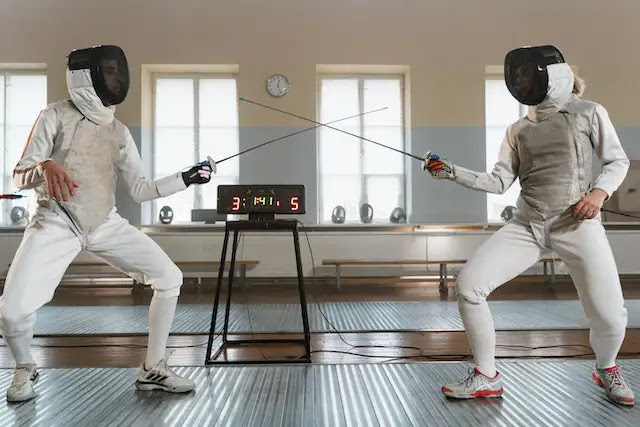Are you curious about the fascinating sport of fencing? Look no further! In this article, we'll explore 100 interesting facts about fencing, a sport that combines skill, strategy, and agility. Whether you're a fencing enthusiast or simply want to expand your knowledge, these facts will provide you with a comprehensive overview of the sport's history, techniques, equipment, and more. So, let's dive into the world of fencing and discover its rich heritage and unique characteristics.
100 Facts About Fencing: Uncover the Rich Heritage and Techniques
- Fencing is a sport that involves two opponents engaging in a sword fight.
- The modern sport of fencing originated in the 18th century.
- Fencing is one of the four sports that has been featured in every modern Olympic Games since 1896.
- The three primary weapons used in fencing are the foil, épée, and sabre.
- The foil is a light, flexible weapon with a small circular guard and a thin, pointed blade.
- The épée is similar to the foil but has a larger guard and a stiffer blade.
- The sabre is a cutting weapon with a flat blade and a guard that extends to cover the hand.
- Fencing bouts take place on a strip called a piste, which is 14 meters long and between 1.5 and 2 meters wide.
- Fencing is governed internationally by the Fédération Internationale d'Escrime (FIE).
- The FIE was founded in 1913 and is based in Lausanne, Switzerland.
- Fencing can be traced back to ancient civilizations such as Egypt and Greece.
- The first recorded organized fencing competition took place in France in the 16th century.
- Fencing was initially practiced as a form of military training and self-defense.
- Fencing has evolved into a modern sport that emphasizes technique, strategy, and agility.
- Fencing requires quick reflexes, footwork, and hand-eye coordination.
- Fencing bouts are scored based on the number of valid touches made by each fencer.
- Fencers wear protective clothing, including a mask, jacket, gloves, and a plastron.
- The mask worn by fencers has a mesh front to protect the face and eyes.
- Fencers are required to salute their opponent before and after a bout.
- Fencing has its own unique set of rules and conventions.
- Fencing terminology includes terms like parry, riposte, lunge, and feint.
- The rules of fencing vary slightly depending on the weapon being used.
- In foil fencing, touches can only be scored with the tip of the weapon on the opponent's torso.
- In épée fencing, touches can be scored with the entire blade on any part of the opponent's body.
- In sabre fencing, touches can be scored with the entire blade above the opponent's waist, including the head and arms.
- Fencers are required to wear a device called a lame, which is a conductive jacket that allows the scoring apparatus to detect valid touches.
- Fencing is considered a safe sport, with a low risk of serious injury.
- Fencing is known for its emphasis on sportsmanship and respect for opponents.
- Fencing is practiced by people of all ages, from children to adults.
- Fencing clubs and schools provide training and coaching for aspiring fencers.
- Fencing competitions are held at various levels, including local, regional, national, and international.
- Fencing is often divided into different age categories, such as cadet, junior, and senior.
- The United States Fencing Association (USFA) is the national governing body for fencing in the United States.
- Fencing has been featured in numerous movies and literature, popularizing the sport.
- Fencing techniques have been adapted for use in stage combat and choreographed fight scenes.
- Fencing requires a combination of physical and mental skills.
- Fencing can improve cardiovascular fitness, coordination, and reflexes.
- Fencing is considered a form of exercise that engages both the body and mind.
- Fencing is included in the curriculum of some schools and universities as a physical education option.
- Fencing is often regarded as a noble and elegant sport.
- Fencing masks are designed to withstand impact and protect the fencer's face.
- Fencing competitions are held on a raised platform called a "piste."
- Fencing bouts are officiated by a referee who enforces the rules and determines the validity of touches.
- Fencing swords are made of flexible, lightweight materials to minimize the risk of injury.
- Fencing bouts are timed, and fencers must score a certain number of touches within the time limit to win.
- Fencing requires agility and quick footwork to evade and attack opponents.
- Fencing techniques are divided into offensive and defensive movements.
- Fencing training often involves drills and exercises to improve speed, accuracy, and coordination.
- Fencing tournaments are organized into individual and team events.
- Fencing events in the Olympic Games include individual and team competitions for each weapon.
- Fencing is a physically demanding sport that requires strength and endurance.
- Fencing blades are scored electronically, and touches are registered by a scoring machine.
- Fencing bouts can be fast-paced and intense, requiring fencers to make split-second decisions.
- Fencing is a sport that values strategy and tactical thinking.
- Fencing competitions follow a bracket system, with fencers progressing through rounds to reach the finals.
- Fencing has a long history of being associated with nobility and the elite.
- Fencing techniques have evolved over time, adapting to changes in armor and weapons.
- Fencing has its own set of etiquette and traditions, including saluting the referee and shaking hands with opponents.
- Fencing masks are tested to ensure they meet safety standards before they can be used in competition.
- Fencing grips come in different styles, allowing fencers to choose the one that best suits their hand and technique.
- Fencing requires good balance and body control to execute precise movements.
- Fencing can be a mentally challenging sport, as fencers must anticipate and react to their opponent's actions.
- Fencing clubs often offer introductory classes for beginners to learn the basics of the sport.
- Fencing bouts can be fast-paced and physically demanding, requiring fencers to be in good physical condition.
- Fencing is considered a lifelong sport, with many fencers continuing to compete well into their senior years.
- Fencing tournaments attract participants from around the world, fostering international camaraderie and competition.
- Fencing is often seen as a niche sport but has a dedicated and passionate community.
- Fencing equipment, such as swords and protective gear, must meet specific regulations and safety standards.
- Fencing is recognized by the International Olympic Committee (IOC) as an official Olympic sport.
- Fencing matches can be intense and highly tactical, with fencers analyzing their opponent's movements and adjusting their strategy accordingly.
- Fencing has its own set of signals and gestures used by referees and fencers to communicate during bouts.
- Fencing requires a combination of strength, speed, agility, and mental focus.
- Fencing bouts are often accompanied by a distinctive sound as the blades clash against each other.
- Fencing is a sport that encourages discipline and self-control.
- Fencing competitions are sometimes held outdoors, adding an extra element of challenge.
- Fencing has a long tradition in European countries, particularly France and Italy.
- Fencing is sometimes referred to as "physical chess" due to its strategic nature.
- Fencing can help improve hand-eye coordination and spatial awareness.
- Fencing coaches play a crucial role in training and developing fencers' skills.
- Fencing is a sport that can be enjoyed by individuals of all body types and sizes.
- Fencing is often featured in historical reenactments and Renaissance festivals.
- Fencing has its own set of rules regarding sportsmanship and fair play.
- Fencing requires fencers to think quickly and make split-second decisions.
- Fencing can help improve reaction time and mental agility.
- Fencing competitions are often lively and energetic, with spectators cheering on their favorite fencers.
- Fencing is a sport that values precision and accuracy.
- Fencing has its own scoring system, with different values assigned to different types of touches.
- Fencing bouts can be physically demanding, with fencers exerting themselves in short bursts of intense activity.
- Fencing is a sport that promotes discipline, respect, and perseverance.
- Fencing has been practiced by military personnel throughout history as a combat skill.
- Fencing has its own set of fencing-specific exercises and training methods.
- Fencing masks are designed to allow good visibility while still providing protection.
- Fencing has its own set of traditions and rituals, adding to the sport's unique atmosphere.
- Fencing is a sport that requires constant learning and improvement.
- Fencing has its own set of hand signals used by fencers to indicate their intentions during a bout.
- Fencing is a physically and mentally engaging sport that can help improve focus and concentration.
- Fencing is often seen as an art form, with fencers displaying grace and elegance in their movements.
- Fencing can be a social activity, with fencers forming friendships and bonds within the fencing community.
- Fencing has its own set of exercises and stretches to warm up and cool down the body before and after bouts.
- Fencing is a sport that can be enjoyed at various levels, from recreational to competitive, catering to different interests and goals.
Conclusion:
In conclusion, fencing is a captivating sport that has evolved over centuries, blending martial arts, athleticism, and tactical prowess. With its three distinct weapons, foil, épée, and sabre, and its emphasis on quick reflexes and precise footwork, fencing offers a thrilling experience for both participants and spectators. Whether you're drawn to the elegance and grace of the sport or its strategic elements reminiscent of a mental chess game, fencing continues to captivate individuals of all ages and backgrounds. So, whether you're inspired to pick up a foil or simply appreciate the artistry of this noble sport, fencing will undoubtedly leave an indelible mark on your understanding of combat and competition.














0 Comments